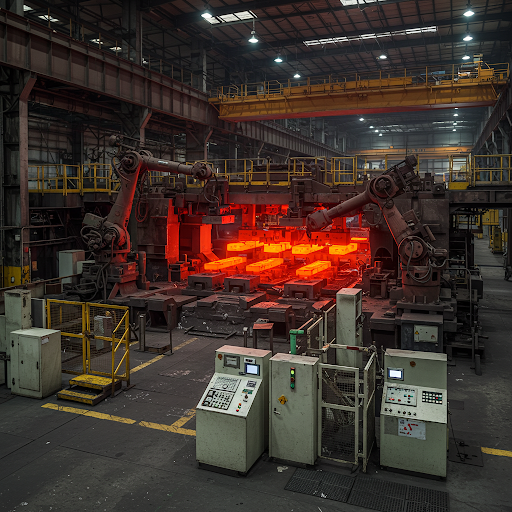Raw Material Handling
At Active Steel Forge, we recognize that the foundation of…

At Active Steel Forge, we recognize that the foundation of…

At Active Steel Forge, we offer advanced heating facilities designed…

Experience unmatched cutting precision and efficiency with our advanced cutting…

At Active Steel Forge, our advanced forging facilities offer unmatched…

At Active Steel Forge, we specialize in providing advanced heat…

Experience unmatched precision and superior quality with our advanced CNC…

5 min Read
Induction heating is a crucial process in modern steel forging, offering unparalleled efficiency, precision, and quality enhancement. This non-contact heating method utilizes electromagnetic induction to heat metal, ensuring uniform temperature distribution and optimal forging conditions. As industries continue to demand higher quality and performance in forged components, induction heating plays a significant role in meeting these standards.
Induction heating works by generating an alternating magnetic field that induces electrical currents (eddy currents) in a conductive material. These currents generate heat due to the material’s resistance, allowing rapid and controlled heating without direct contact with the heating source.
Induction heating enables precise control of temperature, ensuring uniform heating without overheating or burning the material. This is essential for achieving consistent metallurgical properties in forged components.
Compared to traditional heating methods such as gas furnaces, induction heating is significantly more energy-efficient, reducing power consumption and operational costs.
Induction heating reduces cycle times by rapidly bringing steel to forging temperatures, increasing overall productivity and throughput.
Uniform heating minimizes the risk of thermal distortion, reducing stress concentrations and enhancing mechanical properties like toughness and durability.
Since induction heating does not involve combustion, it produces no direct emissions, making it an environmentally friendly choice for steel forging industries.
Induction heating eliminates the need for open flames and hot surfaces, reducing the risk of workplace injuries and improving the overall safety of forging operations.
| Feature | Induction Heating | Traditional Furnace Heating |
|---|---|---|
| Heating Speed | Faster | Slower |
| Energy Efficiency | High | Lower |
| Temperature Control | Precise | Less Precise |
| Environmental Impact | Minimal Emissions | High Emissions |
| Operational Safety | Safer (No Open Flame) | Risk of Burns & Fire |
Induction heating is widely used in various forging applications across multiple industries:
With advancements in technology, induction heating is expected to become even more efficient and integrated into smart manufacturing systems. Innovations in real-time monitoring, AI-driven process control, and energy optimization will further enhance the role of induction heating in steel forging.
Induction heating is a game-changer in the steel forging industry, offering precision, efficiency, and sustainability. By adopting this advanced heating method, manufacturers can ensure superior quality, reduce production costs, and meet the increasing demands for high-performance forged components. As industries continue to evolve, induction heating will remain a cornerstone of modern forging processes, setting new standards for excellence in metal manufacturing.
Get in touch with our experts today
